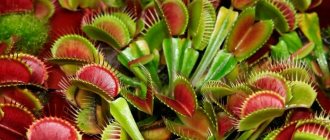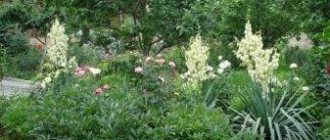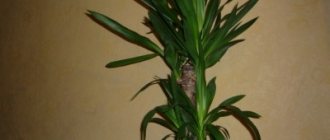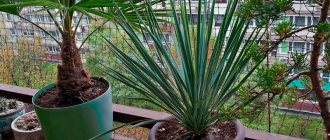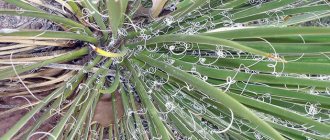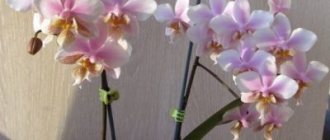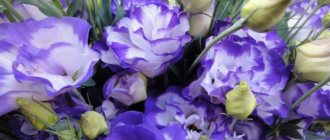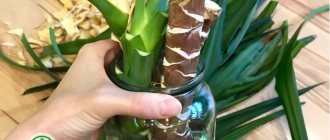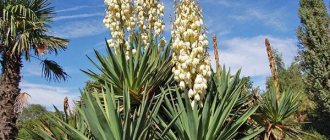Yucca is called the "palm lily". The flower belongs to the Agave family; there are about 40 species. Outwardly it resembles a small palm tree.
The distribution area of yucca is the deserts of North America; several varieties are found in the center of this continent, as well as on the islands of the Caribbean and in Asia. Prefers rocky soils and areas with plenty of sunlight. Garden plants can be up to 10 meters high and look like a tree. At home, yucca does not grow higher than 1 m.
Description
It has a thickened trunk, and therefore belongs to tree-like plants. The leaves are quite hard, sword-shaped, green with a bluish tint, and have thorns at the ends. The edges may be wavy, jagged, or hairy. The leaves are collected in a bunch at the top of the plant, are located on branched trunks, or grow from a rosette directly from the soil.
The crown includes one or more sockets. The palm flowers are white, resembling bells, up to 9 cm long. The inflorescence is an ordinary panicle.
Other colors are also found in nature: cream, yellow, canary, soft green. There are up to 200 flowers on one palm tree. Yucca rarely blooms at home. The fruit of the flower is a juicy capsule; there are also edible varieties.
Is it possible to keep the plant in the house?
Conflicting superstitions associated with pandanus baffle lovers of exotic plants. To decide whether to keep a screw palm in your home, you need to decide whether it is right for you.
Benefits of the flower
Neighborhood with pandanus is favorable for soft, weak-willed, indecisive and pliable people. The screw palm brings positive changes to their character: self-confidence, the ability to maintain moral defense, stamina and endurance in difficult life situations.
In addition, the influence of pandanus allows one to improve the functioning of the human brain, learn to think clearly and logically , clearly express one’s thoughts, grasp new knowledge on the fly, and be vigilant and attentive.
How can it be dangerous?
Due to the aggressive energy of pandanus, some superstitions classify this plant as an energy vampire. It is believed that it:
- creates a difficult and unfriendly atmosphere around himself;
- causes headaches;
- sucks vitality from the owners;
- makes unrestrained and prickly people even more irritable and embittered.
Types of indoor yucca
| View | Description |
| Aloe leaf marginata | It blooms in summer, producing an inflorescence with many bell-shaped flowers. The leaves have toothed edges and the flowers are cream-colored with a purple tint. |
| Whippla | A variety of slow-growing yucca flower. The stem is shortened, the leaves are greenish with a gray tint, collected in a rosette. The edges are jagged with a spike at the tip. It blooms in summer with many bell-shaped flowers that add a light scent. The color is the same as the previous species. The price is about 4000 rubles. |
| Filamentous or Guard | Stemless, frost-resistant, grows wide. Withstands temperatures down to -20°C. The leaves are up to 65 cm long, have a green color with a bluish tint, the tip of the leaf is pointed, and there are white thread-like fibers at the ends. Blooms with yellow flowers. |
| Ivory or Elephantis | It grows slowly and eventually becomes a lush bush. The trunk is thickened, the stem is tree-like. At the top there is a rosette with stiff, light green leaves. It blooms in summer, producing a peduncle up to one meter long. |
| Gray or Candle of the Lord | Evergreen species up to 2 meters high. The leaves are collected in a large rosette, hard, bluish-green in color. There are gray fibers at the ends. Flowering occurs in summer. |
| Glorious or Joanna | A small tree, up to 5 meters long. The young plant does not have a trunk; it is a spherical shrub. It has dark green leaves with a waxy coating. It blooms in summer with white flowers with burgundy tips. As soon as the peduncle falls off, a box with black seeds forms in its place. |
Yucca can be planted together with bonsai or fuchsia. It also stands out beautifully with ficus and spathiphyllus.
Interesting information about Pandan
Pandanus, also known as pandan, adorns the Pandanaceae family with its beauty. A genus of seven hundred and fifty perennial tree-like specimens that like the sultry climate of the Eastern part of the globe.
The homeland can be considered Hawaii, the western part of the African continent, India, Polynesia, Vietnam and up to the Australian continent.
Most of all, pandanus likes the island of Madagascar, which is home to approximately ninety varieties of this plant.
These wonderful screw palms can grow beautifully along river banks, mountain forests, and in the highlands; they even decorate the surface of a volcano, sea coasts and coral reefs.
Natural conditions allow these beauties to reach ten and sometimes twenty meters in height. Externally, pandanuses are similar to vines and palm trees. Tree-branching pandanas are similar to dracaena , but have softer foliage.
In most cases, the Pandanus flower is able to form numerous light roots that stretch to the ground and gradually take root. Throughout its life, the standing position of the screw palm is maintained only thanks to lignified aerial roots, called stilts.
The pandan plant has four-meter long sword-shaped, linear, sharp-serrated leaves at the edges, the width of which reaches fifteen centimeters. The leaves are located on the trunk and form double-row helical spirals. Due to this, the pandan flower has other names - “screw palm” or “screw tree”. Over the years, the leaf blades fall off from below, leaving behind nicks. As a rule, pandanus blooms are observed in a natural microclimate. Its tiny yellow flowers without perianths are concentrated into panicle inflorescences or cobs.
The screw tree practically does not bloom under unnatural circumstances. This unpretentious flower calmly tolerates poor lighting, tolerates a lack of moisture, grows vigorously and in most cases is a guest of large halls. The most interesting point is that the fruits of the screw palm look almost like a pineapple .
Photos of Pandanus can be seen in the next section.
Home care
When growing indoor yucca, you need to pay attention to the following conditions:
| Parameter | Winter | Summer |
| Location/Lighting | Provide additional artificial lighting, since it is advisable for yucca to spend 16 hours a day under light. | Yucca will grow well on the south and southeast side of the room. Young palms will need more light than mature palms. In hot weather they should still be placed in the shade. With a lack of sun, the plant gets sick. |
| Temperature | It is advisable to provide the shrub with slight coolness up to +10°C. You can take it out onto the balcony if it is heated. Otherwise, open the window more often and place the pot closer to the glass. | Comfortable temperature up to +23°C. If it is higher, then you will need to additionally humidify the air. |
| Humidity | No need for high humidity. | When the temperature rises to +25°C, create additional humidity: spray or pour expanded clay into the pot daily and constantly moisten it. |
| Watering | Do not overwater the plant, make sure the soil dries out and reduce the frequency of watering. | Watering should be frequent, but excess water from the pan must be drained in a timely manner, otherwise the roots will rot. |
| Top dressing | No fertilizer needed. | Feed with mineral fertilizers once a week. Suitable compositions for cacti and palm trees. |
Trimming
It promotes the growth of new shoots, from which beautiful and lush bushes are formed. Formation is carried out in March, the upper part is cut off with pruning shears, departing 60 cm from the rosette. You cannot break the trunk, this will lead to a protracted disease of the bush or its death, you need to carefully and sharply cut the stem.
A fresh cut should be sprinkled with charcoal or filled with paraffin, so the yucca will retain moisture inside. After placing the bush in a dark place, after 3 months new shoots will appear at the cut site.
Only plants with a trunk diameter greater than 5 centimeters can be cut. Otherwise, the stem cannot be trimmed.
Choosing a pot, soil, replanting
The first transplant should be carried out immediately after purchasing the plant, and the next one in March. While the shrub is young, it can be replanted annually, after which once every 3 years.
It is advisable to plant directly with a clod of earth on the roots. Be sure to add drainage to the bottom of the pot so that the roots do not rot after watering.
Step-by-step transplant:
- Buy a clay pot with holes in the bottom for drainage, 2 sizes larger than the previous one.
- Pour drainage 4 cm high at the bottom, and sprinkle earth on top.
- With a lump of earth on the roots, transfer the plant to a new pot.
- Fill the remaining empty spaces with soil and compact them gently.
You need to remove black, dry roots in advance, and sprinkle the sections with activated carbon. After transplantation, the yucca does not grow for one and a half months.
Slightly acidic soil is suitable for the plant. It should conduct water and nutrients well to the roots. It is better to add river sand or humus to the soil mixture. There are ready-made compositions for palm trees, cacti and dracaenas in which yucca can be planted.
Yucca or dracaena - five fundamental differences
After much research, scientists agreed that yucca and dracaena belong to the asparagus family, but both are worthy to lead a separate genus.
Without going into botanical terms, it is important to note the signs that allow flower growers in a store to correctly determine the name of a home palm tree.
So, what is the difference between yucca and its twin dracaena? First of all, the texture of the leaves, the diameter of the trunk, and the characteristic root system.
| Yucca | Dracaena |
| the leaf blade is wider, dense, rough to the touch, often distinguished by serrated edges (with jagged edges) | the leaf plate is narrower, thinner, smooth to the touch, with smooth edges |
| tree trunk with the same height of plants has a larger diameter | tree trunk with the same height of plants has a smaller diameter |
| developed root system and trunk produce shoots | the root is smooth with a slight yellowness, orange-yellow when cut, does not produce rhizomes or shoots |
| Fundamental differences in care | |
| prefers dry soil | prefers moist soil |
| spraying is undesirable | loves spraying |
Reproduction
Gardeners propagate yucca in four ways.
Seeds
The main thing here is to choose the right seeds for planting. You can collect them at home only after pollination. Stages:
- File the seeds with sandpaper so that the hard shell is damaged, so they will sprout faster.
- Soak them in water for a day.
- Plant in a small container with a special earthen mixture.
- Cover with film and place in a warm place in the house with good lighting, constantly moisten the soil.
- Wipe the film every day to remove condensation.
- As soon as shoots and leaves appear (in about a month), plant the plants in different containers and feed them with fertilizers on the 10th day.
- After the germination of 5 leaves, the plant is considered mature.
Cuttings
- Make a smooth cut from an adult plant.
- Dry and treat with growth agent.
- For soil, use a mixture of peat and river sand.
- Transfer the cutting to the ground and bury it 3-4 cm in the soil.
- Water the soil well and spray the shoot itself daily.
Parts of the trunk
This way you can propagate an adult plant, but only in the spring. Process:
- Carefully cut off the top of the bush and dry.
- Place the cuttings in water until they form the first roots, then into the soil.
- As soon as the buds produce young shoots, plant them.
Adventitious roots
Used for stemless yucca species. In summer or spring, the root shoots are cut off with a knife, and the seedlings are transplanted into a pot with wet sand.
Folk beliefs associated with indoor plants
- Popular beliefs say that pandanus spreads very powerful and aggressive energy around itself. The plant is able to create a reliable barrier around the home, through which no one else’s hostile energy can penetrate into the room. In this case, pandanus acts as a protector of the house.
- In addition, with the help of its influence, the screw palm endows weak-willed, slow people with activity and the ability to defend their point of view and stand up for themselves. However, the plant does not have the most favorable effect on active and angry people: such people become more aggressive and cruel.
- Another positive value of pandanus: it helps in the formation of a sharp mind and persistent character, accelerates brain activity, enhances attention, vigilance and composure. Therefore, parents whose schoolchildren do not have a thirst for knowledge should place a pot of pandanus in the house.
Errors in care
| Symptom | Error | Elimination |
| The trunk softens and brown spots appear. | The soil is excessively moist. | Maintain regular watering. |
| Dry and light spots form. | Excess light | Maintain temperature conditions. |
| Leaves curl and brown spots appear. | Insufficient humidity and watering. | Scheduled watering and daily spraying. |
| The leaves turn pale and thin. | Poor lighting and high temperatures. | Observe light and temperature conditions. |
Diseases, pests
| Symptom (what happens to the leaves) | Disease/Pest | Treatment |
| Drying. |
| Regular watering, spraying the plant and humidifying the air in the room. |
| They turn yellow. | This is a natural process. The leaves live for a couple of years, then turn yellow and die. | No treatment required. |
| They fall off. |
| Observe the watering schedule, provide heat and close the windows. |
| Light spots form on them. | Too much light. | Observe the light regime. |
| Rolled into a tube. | The reason is hypothermia. | Adjust the room temperature. |
| Dark spots appear on them. |
| Remove affected leaves and spray the plant with fungicide. Reduce watering. |
| They turn pale and stretch out. |
| Observe heat and light conditions. |
| Pests are visible on them: mites, aphids and caterpillars. | Excessive watering. | Spray with insecticides. |
Feng Shui meaning
According to the eastern teachings of Feng Shui, pandanus is the embodiment of the energy of wood . A screw palm in the house helps to attract wealth, health, opportunities for renewal and favorable changes, and improve relationships between family members. But only if you keep no more than one plant in the house. Abusing the element of wood will deprive people of integrity and peace of mind, making them aggressive and irritable.
